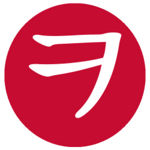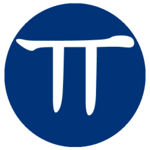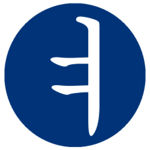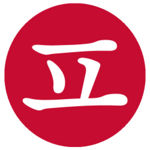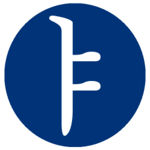Difference between revisions of "Hangeul step 4/nl"
DigitalSoju (Talk | contribs) (Ready for translation in Dutch) |
(vowel -> klinker) |
||
| (8 intermediate revisions by 2 users not shown) | |||
| Line 3: | Line 3: | ||
{| border=0 style="text-align:center; margin-left: auto; margin-right: auto;" | {| border=0 style="text-align:center; margin-left: auto; margin-right: auto;" | ||
|- | |- | ||
| − | | [[File: | + | | [[File:Vorige.png|link=Hangeul step 3b/nl|150px]] |
| − | | [[File: | + | | [[File:Volgende.png|link=Hangeul step 4b/nl|150px]] |
|} | |} | ||
| − | == | + | ==Aangeblazen medeklinkers== |
[[File:Similar letters consonants.png|right|]] | [[File:Similar letters consonants.png|right|]] | ||
| − | In | + | In dit deel leren we de aangeblazen medeklinkers [[ㅋ]], [[ㅌ]], [[ㅊ]], en [[ㅍ]] (en nog een medeklinker, [[ㅎ]]). Zie je op het plaatje rechts een verschil tussen de oude letters die we al geleerd hebben (bovenste rij) en de onderste rij? |
| − | + | Voor ik verder ga, moet ik even uitleggen wat geaspireerd of aangeblazen betekent. Bij aanblazen laat je bij het maken van een klank een sterke luchtstroom naar buiten komen. Om het verschil tussen aangeblazen en niet aangeblazen klanken te oefenen kun je een aangestoken lucifer voor je mond houden. Als je een aangeblazen klank maakt, moet het vlammetje flikkeren. Bij niet aangeblazen klanken blijft het vlammetje onbewogen. Het Nederlands kent zelf geen aangeblazen medeklinkers. | |
| − | + | De nieuwe letters die we gaan leren zijn gewoon de aangeblazen versies van de oude letters die we al kennen; we spreken ze op dezelfde manier uit maar nu stoten we er lucht bij uit. En misschien was het je al opgevallen dat deze letters gewoon de niet aangeblazen medeklinkers zijn maar dan met een extra streep. | |
#Source: [[Wikipedia:Aspiration_(phonetics)]] | #Source: [[Wikipedia:Aspiration_(phonetics)]] | ||
{{-}} | {{-}} | ||
| − | == | + | ==Klinkers met J-klank== |
[[File:Similar letters vowels.png|right|450px]] | [[File:Similar letters vowels.png|right|450px]] | ||
| − | + | In dit deel leren we de klinkers [[ㅑ]], [[ㅕ]], [[ㅛ]], [[ㅠ]], [[ㅖ]] en [[ㅒ]]. Zie je op het plaatje rechts nu ook het verschil tussen de oude letters die we al geleerd hebben (bovenste rij) en de onderste rij? Deze nieuwe klinkers krijgen een /j/-klank (IPA: /j/) voor onze al geleerde klinkers. Een eenvoudig voorbeeld is de al geleerde klank ㅜ waarvan we weten dat hij lijkt op de oe in het woord "koe". Om de ㅠ te krijgen zetten we een /j/-klank voor de ㅜ en nu klinkt hij als "joe". | |
{{-}} | {{-}} | ||
| − | ==ㅅ | + | ==ㅅ herinnering== |
| − | + | Weet je nog dat we in Stap 3 zeiden dat '''ㅅ''' in combinatie met de klinkers ㅣ, '''ㅕ, ㅑ, ㅠ, ㅛ''' wordt uitgesproken als "sj"? Je zegt altijd "sj" in combinatie met een van deze dubbelstrepige klinkers en de klinker ㅣ. | |
| − | ==Begin | + | ==Begin van de les== |
{{Hangeul intro table/nl | {{Hangeul intro table/nl | ||
| Line 31: | Line 31: | ||
|Consonant = ㅋ | |Consonant = ㅋ | ||
|Cons image = ㅋ.jpg | |Cons image = ㅋ.jpg | ||
| − | |Cons text = | + | |Cons text = Dit is een aangeblazen /k/. Hij wordt precies zoals de ㄱ uitgesproken maar dan met meer lucht. Zie voor de volledige informatie over deze letter [[ㅋ]]. |
|Vowel = ㅛ | |Vowel = ㅛ | ||
|Vowel image = ㅛ.jpg | |Vowel image = ㅛ.jpg | ||
| − | |Vowel text = | + | |Vowel text = Deze wordt net als de ㅗ uitgesproken maar dan met een /j/-klank ervoor. Zie voor de volledige informatie over deze letter [[ㅛ]]. |
| − | |Vowel audio description1 = | + | |Vowel audio description1 = Man |
|Vowel audio1 = <flashmp3>yo J.mp3|leftbg=003478|rightbg=c60c30|lefticon=ffffff|righticon=ffffff</flashmp3> | |Vowel audio1 = <flashmp3>yo J.mp3|leftbg=003478|rightbg=c60c30|lefticon=ffffff|righticon=ffffff</flashmp3> | ||
| − | |Vowel audio description2 = | + | |Vowel audio description2 = Vrouw |
|Vowel audio2 = <flashmp3>yo C.mp3|leftbg=003478|rightbg=c60c30|lefticon=ffffff|righticon=ffffff</flashmp3> | |Vowel audio2 = <flashmp3>yo C.mp3|leftbg=003478|rightbg=c60c30|lefticon=ffffff|righticon=ffffff</flashmp3> | ||
}} | }} | ||
| Line 43: | Line 43: | ||
{| class="wikitable" style="text-align:center; margin-left: auto; margin-right: auto;font-size:300%;" | {| class="wikitable" style="text-align:center; margin-left: auto; margin-right: auto;font-size:300%;" | ||
|-style="font-size:70%" | |-style="font-size:70%" | ||
| − | !colspan="2"| | + | !colspan="2"|Oefening |
|- | |- | ||
| 카 | | 카 | ||
| Line 68: | Line 68: | ||
|Consonant = ㅌ | |Consonant = ㅌ | ||
|Cons image = ㅌ.jpg | |Cons image = ㅌ.jpg | ||
| − | |Cons text = | + | |Cons text = Dit is een aangeblazen /t/. Hij wordt net als de ㄷ uitgesproken maar dan met meer lucht. Zie voor de volledige informatie over deze letter [[ㅌ]]. |
|Vowel = ㅠ | |Vowel = ㅠ | ||
|Vowel image = ㅠ.jpg | |Vowel image = ㅠ.jpg | ||
| − | |Vowel text = | + | |Vowel text = Deze wordt net als de ㅜ uitgesproken maar dan met een /j/-klank ervoor. Bijna als "joe" in het woord joelen. Zie voor de volledige informatie over deze letter [[ㅠ]]. |
| − | |Vowel audio description1 = | + | |Vowel audio description1 = Man |
|Vowel audio1 = <flashmp3>yu J.mp3|leftbg=003478|rightbg=c60c30|lefticon=ffffff|righticon=ffffff</flashmp3> | |Vowel audio1 = <flashmp3>yu J.mp3|leftbg=003478|rightbg=c60c30|lefticon=ffffff|righticon=ffffff</flashmp3> | ||
| − | |Vowel audio description2 = | + | |Vowel audio description2 = Vrouw |
|Vowel audio2 = <flashmp3>yu C.mp3|leftbg=003478|rightbg=c60c30|lefticon=ffffff|righticon=ffffff</flashmp3> | |Vowel audio2 = <flashmp3>yu C.mp3|leftbg=003478|rightbg=c60c30|lefticon=ffffff|righticon=ffffff</flashmp3> | ||
}} | }} | ||
| Line 80: | Line 80: | ||
{| class="wikitable" style="text-align:center; margin-left: auto; margin-right: auto;font-size:300%;" | {| class="wikitable" style="text-align:center; margin-left: auto; margin-right: auto;font-size:300%;" | ||
|-style="font-size:70%" | |-style="font-size:70%" | ||
| − | !colspan="2"| | + | !colspan="2"|Oefening |
|- | |- | ||
| 투 | | 투 | ||
| Line 102: | Line 102: | ||
|Consonant = ㅍ | |Consonant = ㅍ | ||
|Cons image = ㅍ.jpg | |Cons image = ㅍ.jpg | ||
| − | |Cons text = | + | |Cons text = Dit is een aangeblazen /p/. Hij wordt net als de ㅂ uitgesproken maar dan met meer lucht. Zie voor de volledige informatie over deze letter [[ㅍ]]. |
|Vowel = ㅕ | |Vowel = ㅕ | ||
|Vowel image = ㅕ.jpg | |Vowel image = ㅕ.jpg | ||
| − | |Vowel text = | + | |Vowel text = Deze wordt net als de ㅓ uitgesproken maar dan met een /j/-klank ervoor. Zie voor de volledige informatie over deze letter [[ㅕ]]. |
| − | |Vowel audio description1 = | + | |Vowel audio description1 = Man |
|Vowel audio1 = <flashmp3>yeo J.mp3|leftbg=003478|rightbg=c60c30|lefticon=ffffff|righticon=ffffff</flashmp3> | |Vowel audio1 = <flashmp3>yeo J.mp3|leftbg=003478|rightbg=c60c30|lefticon=ffffff|righticon=ffffff</flashmp3> | ||
| − | |Vowel audio description2 = | + | |Vowel audio description2 = Vrouw |
|Vowel audio2 = <flashmp3>yeo C.mp3|leftbg=003478|rightbg=c60c30|lefticon=ffffff|righticon=ffffff</flashmp3> | |Vowel audio2 = <flashmp3>yeo C.mp3|leftbg=003478|rightbg=c60c30|lefticon=ffffff|righticon=ffffff</flashmp3> | ||
}} | }} | ||
| Line 115: | Line 115: | ||
{| class="wikitable" style="text-align:center; margin-left: auto; margin-right: auto;font-size:300%;" | {| class="wikitable" style="text-align:center; margin-left: auto; margin-right: auto;font-size:300%;" | ||
|-style="font-size:70%" | |-style="font-size:70%" | ||
| − | !colspan="2"| | + | !colspan="2"|Oefening |
|- | |- | ||
| 피 | | 피 | ||
| Line 148: | Line 148: | ||
|Consonant = ㅊ | |Consonant = ㅊ | ||
|Cons image = ㅊ.jpg | |Cons image = ㅊ.jpg | ||
| − | |Cons text = | + | |Cons text = Dit is een /ch/-klank. Hij wordt net als de ㅈ uitgesproken maar dan met meer lucht. Zie voor de volledige informatie over deze letter [[ㅊ]]. |
|Vowel = ㅑ | |Vowel = ㅑ | ||
|Vowel image = ㅑ.jpg | |Vowel image = ㅑ.jpg | ||
| − | |Vowel text = | + | |Vowel text = Deze wordt net als de ㅏ uitgesproken maar dan met een /j/-klank ervoor. Zie voor de volledige informatie over deze letter [[ㅑ]]. |
| − | |Vowel audio description1 = | + | |Vowel audio description1 = Man |
|Vowel audio1 = <flashmp3>ya J.mp3|leftbg=003478|rightbg=c60c30|lefticon=ffffff|righticon=ffffff</flashmp3> | |Vowel audio1 = <flashmp3>ya J.mp3|leftbg=003478|rightbg=c60c30|lefticon=ffffff|righticon=ffffff</flashmp3> | ||
| − | |Vowel audio description2 = | + | |Vowel audio description2 = Vrouw |
|Vowel audio2 = <flashmp3>ya C.mp3|leftbg=003478|rightbg=c60c30|lefticon=ffffff|righticon=ffffff</flashmp3> | |Vowel audio2 = <flashmp3>ya C.mp3|leftbg=003478|rightbg=c60c30|lefticon=ffffff|righticon=ffffff</flashmp3> | ||
}} | }} | ||
| Line 161: | Line 161: | ||
{| class="wikitable" style="text-align:center; margin-left: auto; margin-right: auto;font-size:300%;" | {| class="wikitable" style="text-align:center; margin-left: auto; margin-right: auto;font-size:300%;" | ||
|-style="font-size:70%" | |-style="font-size:70%" | ||
| − | !colspan="2"| | + | !colspan="2"|Oefening |
|- | |- | ||
| 지 | | 지 | ||
| Line 187: | Line 187: | ||
|Consonant = ㅎ | |Consonant = ㅎ | ||
|Cons image = ㅎ.jpg | |Cons image = ㅎ.jpg | ||
| − | |Cons text = | + | |Cons text = Dit is een /h/-klank. Zie voor de volledige informatie over deze letter [[ㅎ]]. |
|Vowel = ㅖ | |Vowel = ㅖ | ||
|Vowel image = ㅖ.jpg | |Vowel image = ㅖ.jpg | ||
| − | |Vowel text = | + | |Vowel text = Deze wordt net als de ㅔ uitgesproken maar dan met een /j/-klank ervoor. Zie voor de volledige informatie over deze letter [[ㅖ]]. |
| − | |Vowel audio description1 = | + | |Vowel audio description1 = Man |
|Vowel audio1 = <flashmp3>Ye J.mp3|leftbg=003478|rightbg=c60c30|lefticon=ffffff|righticon=ffffff</flashmp3> | |Vowel audio1 = <flashmp3>Ye J.mp3|leftbg=003478|rightbg=c60c30|lefticon=ffffff|righticon=ffffff</flashmp3> | ||
| − | |Vowel audio description2 = | + | |Vowel audio description2 = Vrouw |
|Vowel audio2 = <flashmp3>Ye C.mp3|leftbg=003478|rightbg=c60c30|lefticon=ffffff|righticon=ffffff</flashmp3> | |Vowel audio2 = <flashmp3>Ye C.mp3|leftbg=003478|rightbg=c60c30|lefticon=ffffff|righticon=ffffff</flashmp3> | ||
}} | }} | ||
| Line 200: | Line 200: | ||
{| class="wikitable" style="text-align:center; margin-left: auto; margin-right: auto;font-size:300%;" | {| class="wikitable" style="text-align:center; margin-left: auto; margin-right: auto;font-size:300%;" | ||
|-style="font-size:70%" | |-style="font-size:70%" | ||
| − | !colspan="2"| | + | !colspan="2"|Oefening |
|- | |- | ||
| 히 | | 히 | ||
| Line 223: | Line 223: | ||
{{Hangeul intro table extra | {{Hangeul intro table extra | ||
| − | |char = ㅒ ( | + | |char = ㅒ (klinker) |
|Image = ㅒ.jpg | |Image = ㅒ.jpg | ||
| − | |Text = | + | |Text = Deze wordt net als de ㅐ uitgesproken maar dan met een /j/-klank ervoor (verschilt niet veel van ㅖ) Zie voor de volledige informatie over deze letter [[ㅒ]]. |
|link = ㅒ | |link = ㅒ | ||
|Bgcolor = {{Kblue}} | |Bgcolor = {{Kblue}} | ||
| − | |Audio description1 = | + | |Audio description1 = Man |
|Audio1 = <flashmp3>yae J.mp3|leftbg=003478|rightbg=c60c30|lefticon=ffffff|righticon=ffffff</flashmp3> | |Audio1 = <flashmp3>yae J.mp3|leftbg=003478|rightbg=c60c30|lefticon=ffffff|righticon=ffffff</flashmp3> | ||
| − | |Audio description2 = | + | |Audio description2 = Vrouw |
|Audio2 = <flashmp3>yae C.mp3|leftbg=003478|rightbg=c60c30|lefticon=ffffff|righticon=ffffff</flashmp3> | |Audio2 = <flashmp3>yae C.mp3|leftbg=003478|rightbg=c60c30|lefticon=ffffff|righticon=ffffff</flashmp3> | ||
}} | }} | ||
| Line 237: | Line 237: | ||
{| class="wikitable" style="text-align:center; margin-left: auto; margin-right: auto;font-size:300%;" | {| class="wikitable" style="text-align:center; margin-left: auto; margin-right: auto;font-size:300%;" | ||
|-style="font-size:70%" | |-style="font-size:70%" | ||
| − | !colspan="2"| | + | !colspan="2"|Oefening |
|- | |- | ||
| 걔 | | 걔 | ||
| Line 246: | Line 246: | ||
|} | |} | ||
| − | == | + | ==Echte voorbeelden== |
| − | + | Oefen met deze echte Koreaanse woorden. De voorbeelden voor stap 4 zijn opgesplitst. De helft van de voorbeelden voor stap 4 staan hier en de andere helft op de volgende bladzijde. | |
{| class="wikitable" style="text-align:center; margin-left: auto; margin-right: auto;" | {| class="wikitable" style="text-align:center; margin-left: auto; margin-right: auto;" | ||
|- | |- | ||
| − | ! | + | ! Woord !! Audio |
|- | |- | ||
| − | | 가르치다 ( | + | | 가르치다 (lesgeven) |
| <flashmp3>gareuchida J.mp3, gareuchida C.mp3|leftbg=003478|rightbg=c60c30|lefticon=ffffff|righticon=ffffff|loop=yes</flashmp3> | | <flashmp3>gareuchida J.mp3, gareuchida C.mp3|leftbg=003478|rightbg=c60c30|lefticon=ffffff|righticon=ffffff|loop=yes</flashmp3> | ||
|- | |- | ||
| − | | 가리키다 ( | + | | 가리키다 (wijzen naar) |
| <flashmp3>garikida J.mp3, garikida C.mp3|leftbg=003478|rightbg=c60c30|lefticon=ffffff|righticon=ffffff|loop=yes</flashmp3> | | <flashmp3>garikida J.mp3, garikida C.mp3|leftbg=003478|rightbg=c60c30|lefticon=ffffff|righticon=ffffff|loop=yes</flashmp3> | ||
|- | |- | ||
| − | | 가치 ( | + | | 가치 (waarde) |
| <flashmp3>gachi J.mp3, gachi C.mp3|leftbg=003478|rightbg=c60c30|lefticon=ffffff|righticon=ffffff|loop=yes</flashmp3> | | <flashmp3>gachi J.mp3, gachi C.mp3|leftbg=003478|rightbg=c60c30|lefticon=ffffff|righticon=ffffff|loop=yes</flashmp3> | ||
|- | |- | ||
| − | | 고추 ( | + | | 고추 (Spaanse peper) |
| <flashmp3>gochu J.mp3, gochu C.mp3|leftbg=003478|rightbg=c60c30|lefticon=ffffff|righticon=ffffff|loop=yes</flashmp3> | | <flashmp3>gochu J.mp3, gochu C.mp3|leftbg=003478|rightbg=c60c30|lefticon=ffffff|righticon=ffffff|loop=yes</flashmp3> | ||
|- | |- | ||
| − | | 고프다 ( | + | | 고프다 (honger hebben) |
| <flashmp3>gopeuda J.mp3, gopeuda C.mp3|leftbg=003478|rightbg=c60c30|lefticon=ffffff|righticon=ffffff|loop=yes</flashmp3> | | <flashmp3>gopeuda J.mp3, gopeuda C.mp3|leftbg=003478|rightbg=c60c30|lefticon=ffffff|righticon=ffffff|loop=yes</flashmp3> | ||
|- | |- | ||
| Line 271: | Line 271: | ||
| <flashmp3>gyosu J.mp3, gyosu C.mp3|leftbg=003478|rightbg=c60c30|lefticon=ffffff|righticon=ffffff|loop=yes</flashmp3> | | <flashmp3>gyosu J.mp3, gyosu C.mp3|leftbg=003478|rightbg=c60c30|lefticon=ffffff|righticon=ffffff|loop=yes</flashmp3> | ||
|- | |- | ||
| − | | 구타 ( | + | | 구타 (klap) |
| <flashmp3>guta J.mp3, guta C.mp3|leftbg=003478|rightbg=c60c30|lefticon=ffffff|righticon=ffffff|loop=yes</flashmp3> | | <flashmp3>guta J.mp3, guta C.mp3|leftbg=003478|rightbg=c60c30|lefticon=ffffff|righticon=ffffff|loop=yes</flashmp3> | ||
|- | |- | ||
| − | | 구토 ( | + | | 구토 (braaksel) |
| <flashmp3>guto J.mp3, guto C.mp3|leftbg=003478|rightbg=c60c30|lefticon=ffffff|righticon=ffffff|loop=yes</flashmp3> | | <flashmp3>guto J.mp3, guto C.mp3|leftbg=003478|rightbg=c60c30|lefticon=ffffff|righticon=ffffff|loop=yes</flashmp3> | ||
|- | |- | ||
| − | | 구치소 ( | + | | 구치소 (gevangenis) |
| <flashmp3>guchiso J.mp3, guchiso C.mp3|leftbg=003478|rightbg=c60c30|lefticon=ffffff|righticon=ffffff|loop=yes</flashmp3> | | <flashmp3>guchiso J.mp3, guchiso C.mp3|leftbg=003478|rightbg=c60c30|lefticon=ffffff|righticon=ffffff|loop=yes</flashmp3> | ||
|- | |- | ||
| − | | 구하다 ( | + | | 구하다 (redden) |
| <flashmp3>guhada J.mp3, guhada C.mp3|leftbg=003478|rightbg=c60c30|lefticon=ffffff|righticon=ffffff|loop=yes</flashmp3> | | <flashmp3>guhada J.mp3, guhada C.mp3|leftbg=003478|rightbg=c60c30|lefticon=ffffff|righticon=ffffff|loop=yes</flashmp3> | ||
|- | |- | ||
| − | | 구호 ( | + | | 구호 (slogan, motto) |
| <flashmp3>guho J.mp3, guho C.mp3|leftbg=003478|rightbg=c60c30|lefticon=ffffff|righticon=ffffff|loop=yes</flashmp3> | | <flashmp3>guho J.mp3, guho C.mp3|leftbg=003478|rightbg=c60c30|lefticon=ffffff|righticon=ffffff|loop=yes</flashmp3> | ||
|- | |- | ||
| Line 289: | Line 289: | ||
| <flashmp3>gigye J.mp3, gigye C.mp3|leftbg=003478|rightbg=c60c30|lefticon=ffffff|righticon=ffffff|loop=yes</flashmp3> | | <flashmp3>gigye J.mp3, gigye C.mp3|leftbg=003478|rightbg=c60c30|lefticon=ffffff|righticon=ffffff|loop=yes</flashmp3> | ||
|- | |- | ||
| − | | 기타 ( | + | | 기타 (gitaar) |
| <flashmp3>gita J.mp3, gita C.mp3|leftbg=003478|rightbg=c60c30|lefticon=ffffff|righticon=ffffff|loop=yes</flashmp3> | | <flashmp3>gita J.mp3, gita C.mp3|leftbg=003478|rightbg=c60c30|lefticon=ffffff|righticon=ffffff|loop=yes</flashmp3> | ||
|- | |- | ||
| − | | 기차 ( | + | | 기차 (trein) |
| <flashmp3>gicha J.mp3, gicha C.mp3|leftbg=003478|rightbg=c60c30|lefticon=ffffff|righticon=ffffff|loop=yes</flashmp3> | | <flashmp3>gicha J.mp3, gicha C.mp3|leftbg=003478|rightbg=c60c30|lefticon=ffffff|righticon=ffffff|loop=yes</flashmp3> | ||
|- | |- | ||
| − | | 기차표 ( | + | | 기차표 (treinkaartje) |
| <flashmp3>gichapyo J.mp3, gichapyo C.mp3|leftbg=003478|rightbg=c60c30|lefticon=ffffff|righticon=ffffff|loop=yes</flashmp3> | | <flashmp3>gichapyo J.mp3, gichapyo C.mp3|leftbg=003478|rightbg=c60c30|lefticon=ffffff|righticon=ffffff|loop=yes</flashmp3> | ||
|- | |- | ||
| − | | 기체 (gas, | + | | 기체 (gas, lucht) |
| <flashmp3>giche J.mp3, giche C.mp3|leftbg=003478|rightbg=c60c30|lefticon=ffffff|righticon=ffffff|loop=yes</flashmp3> | | <flashmp3>giche J.mp3, giche C.mp3|leftbg=003478|rightbg=c60c30|lefticon=ffffff|righticon=ffffff|loop=yes</flashmp3> | ||
|- | |- | ||
| Line 304: | Line 304: | ||
| <flashmp3>gicho J.mp3, gicho C.mp3|leftbg=003478|rightbg=c60c30|lefticon=ffffff|righticon=ffffff|loop=yes</flashmp3> | | <flashmp3>gicho J.mp3, gicho C.mp3|leftbg=003478|rightbg=c60c30|lefticon=ffffff|righticon=ffffff|loop=yes</flashmp3> | ||
|- | |- | ||
| − | | 기호 ( | + | | 기호 (symbool, teken) |
| <flashmp3>giho J.mp3, giho C.mp3|leftbg=003478|rightbg=c60c30|lefticon=ffffff|righticon=ffffff|loop=yes</flashmp3> | | <flashmp3>giho J.mp3, giho C.mp3|leftbg=003478|rightbg=c60c30|lefticon=ffffff|righticon=ffffff|loop=yes</flashmp3> | ||
|- | |- | ||
| − | | 나타나다 ( | + | | 나타나다 (verschijnen) |
| <flashmp3>natanada J.mp3, natanada C.mp3|leftbg=003478|rightbg=c60c30|lefticon=ffffff|righticon=ffffff|loop=yes</flashmp3> | | <flashmp3>natanada J.mp3, natanada C.mp3|leftbg=003478|rightbg=c60c30|lefticon=ffffff|righticon=ffffff|loop=yes</flashmp3> | ||
|- | |- | ||
| − | | 노예 ( | + | | 노예 (slaaf) |
| <flashmp3>noye J.mp3, noye C.mp3|leftbg=003478|rightbg=c60c30|lefticon=ffffff|righticon=ffffff|loop=yes</flashmp3> | | <flashmp3>noye J.mp3, noye C.mp3|leftbg=003478|rightbg=c60c30|lefticon=ffffff|righticon=ffffff|loop=yes</flashmp3> | ||
|- | |- | ||
| − | | 노크 ( | + | | 노크 (klop) |
| <flashmp3>knock J.mp3, knock C.mp3|leftbg=003478|rightbg=c60c30|lefticon=ffffff|righticon=ffffff|loop=yes</flashmp3> | | <flashmp3>knock J.mp3, knock C.mp3|leftbg=003478|rightbg=c60c30|lefticon=ffffff|righticon=ffffff|loop=yes</flashmp3> | ||
|- | |- | ||
| − | | 노처녀 ( | + | | 노처녀 (oude vrijster) |
| <flashmp3>nocheonyeo J.mp3, nocheonyeo C.mp3|leftbg=003478|rightbg=c60c30|lefticon=ffffff|righticon=ffffff|loop=yes</flashmp3> | | <flashmp3>nocheonyeo J.mp3, nocheonyeo C.mp3|leftbg=003478|rightbg=c60c30|lefticon=ffffff|righticon=ffffff|loop=yes</flashmp3> | ||
|- | |- | ||
| − | | 니트 ( | + | | 니트 (breiwerk) |
| <flashmp3>knit J.mp3, knit C.mp3|leftbg=003478|rightbg=c60c30|lefticon=ffffff|righticon=ffffff|loop=yes</flashmp3> | | <flashmp3>knit J.mp3, knit C.mp3|leftbg=003478|rightbg=c60c30|lefticon=ffffff|righticon=ffffff|loop=yes</flashmp3> | ||
|- | |- | ||
| − | | 다치다 ( | + | | 다치다 (gewond raken) |
| <flashmp3>dachida J.mp3, dachida C.mp3|leftbg=003478|rightbg=c60c30|lefticon=ffffff|righticon=ffffff|loop=yes</flashmp3> | | <flashmp3>dachida J.mp3, dachida C.mp3|leftbg=003478|rightbg=c60c30|lefticon=ffffff|righticon=ffffff|loop=yes</flashmp3> | ||
|- | |- | ||
| − | | 대여 ( | + | | 대여 (lening) |
| <flashmp3>daeyeo J.mp3, daeyeo C.mp3|leftbg=003478|rightbg=c60c30|lefticon=ffffff|righticon=ffffff|loop=yes</flashmp3> | | <flashmp3>daeyeo J.mp3, daeyeo C.mp3|leftbg=003478|rightbg=c60c30|lefticon=ffffff|righticon=ffffff|loop=yes</flashmp3> | ||
|- | |- | ||
| − | | 도토리 ( | + | | 도토리 (eikel [van een eik]) |
| <flashmp3>dotori J.mp3, dotori C.mp3|leftbg=003478|rightbg=c60c30|lefticon=ffffff|righticon=ffffff|loop=yes</flashmp3> | | <flashmp3>dotori J.mp3, dotori C.mp3|leftbg=003478|rightbg=c60c30|lefticon=ffffff|righticon=ffffff|loop=yes</flashmp3> | ||
|- | |- | ||
| − | | 도표 ( | + | | 도표 (schema, rooster, graaf) |
| <flashmp3>dopyo J.mp3, dopyo C.mp3|leftbg=003478|rightbg=c60c30|lefticon=ffffff|righticon=ffffff|loop=yes</flashmp3> | | <flashmp3>dopyo J.mp3, dopyo C.mp3|leftbg=003478|rightbg=c60c30|lefticon=ffffff|righticon=ffffff|loop=yes</flashmp3> | ||
|- | |- | ||
| − | | 마치다 ( | + | | 마치다 (eindigen) |
| <flashmp3>machida J.mp3, machida C.mp3|leftbg=003478|rightbg=c60c30|lefticon=ffffff|righticon=ffffff|loop=yes</flashmp3> | | <flashmp3>machida J.mp3, machida C.mp3|leftbg=003478|rightbg=c60c30|lefticon=ffffff|righticon=ffffff|loop=yes</flashmp3> | ||
|- | |- | ||
| − | | 매표소 ( | + | | 매표소 (kaartjesbureau) |
| <flashmp3>maepyoso J.mp3, maepyoso C.mp3|leftbg=003478|rightbg=c60c30|lefticon=ffffff|righticon=ffffff|loop=yes</flashmp3> | | <flashmp3>maepyoso J.mp3, maepyoso C.mp3|leftbg=003478|rightbg=c60c30|lefticon=ffffff|righticon=ffffff|loop=yes</flashmp3> | ||
|- | |- | ||
| − | | 며느리 ( | + | | 며느리 (schoondochter) |
| <flashmp3>myeoneuri J.mp3, myeoneuri C.mp3|leftbg=003478|rightbg=c60c30|lefticon=ffffff|righticon=ffffff|loop=yes</flashmp3> | | <flashmp3>myeoneuri J.mp3, myeoneuri C.mp3|leftbg=003478|rightbg=c60c30|lefticon=ffffff|righticon=ffffff|loop=yes</flashmp3> | ||
|- | |- | ||
| − | | 모피 ( | + | | 모피 (bont) |
| <flashmp3>mopi J.mp3, mopi C.mp3|leftbg=003478|rightbg=c60c30|lefticon=ffffff|righticon=ffffff|loop=yes</flashmp3> | | <flashmp3>mopi J.mp3, mopi C.mp3|leftbg=003478|rightbg=c60c30|lefticon=ffffff|righticon=ffffff|loop=yes</flashmp3> | ||
|- | |- | ||
| − | | 묘지 ( | + | | 묘지 (graf) |
| <flashmp3>myoji J.mp3, myoji C.mp3|leftbg=003478|rightbg=c60c30|lefticon=ffffff|righticon=ffffff|loop=yes</flashmp3> | | <flashmp3>myoji J.mp3, myoji C.mp3|leftbg=003478|rightbg=c60c30|lefticon=ffffff|righticon=ffffff|loop=yes</flashmp3> | ||
|- | |- | ||
| − | | 미치다 ( | + | | 미치다 (gek zijn) |
| <flashmp3>michida J.mp3, michida C.mp3|leftbg=003478|rightbg=c60c30|lefticon=ffffff|righticon=ffffff|loop=yes</flashmp3> | | <flashmp3>michida J.mp3, michida C.mp3|leftbg=003478|rightbg=c60c30|lefticon=ffffff|righticon=ffffff|loop=yes</flashmp3> | ||
|- | |- | ||
| − | | 바코드 ( | + | | 바코드 (streepjescode) |
| <flashmp3>bakod J.mp3, bakod C.mp3|leftbg=003478|rightbg=c60c30|lefticon=ffffff|righticon=ffffff|loop=yes</flashmp3> | | <flashmp3>bakod J.mp3, bakod C.mp3|leftbg=003478|rightbg=c60c30|lefticon=ffffff|righticon=ffffff|loop=yes</flashmp3> | ||
|- | |- | ||
| − | | 배터리 ( | + | | 배터리 (batterij) |
| <flashmp3>battery J.mp3, battery C.mp3|leftbg=003478|rightbg=c60c30|lefticon=ffffff|righticon=ffffff|loop=yes</flashmp3> | | <flashmp3>battery J.mp3, battery C.mp3|leftbg=003478|rightbg=c60c30|lefticon=ffffff|righticon=ffffff|loop=yes</flashmp3> | ||
|- | |- | ||
| − | | 배추 (Chinese | + | | 배추 (Chinese kool) |
| <flashmp3>baechu J.mp3, baechu C.mp3|leftbg=003478|rightbg=c60c30|lefticon=ffffff|righticon=ffffff|loop=yes</flashmp3> | | <flashmp3>baechu J.mp3, baechu C.mp3|leftbg=003478|rightbg=c60c30|lefticon=ffffff|righticon=ffffff|loop=yes</flashmp3> | ||
|- | |- | ||
| − | | 벼 ( | + | | 벼 (rijstplant) |
| <flashmp3>byeo J.mp3, byeo C.mp3|leftbg=003478|rightbg=c60c30|lefticon=ffffff|righticon=ffffff|loop=yes</flashmp3> | | <flashmp3>byeo J.mp3, byeo C.mp3|leftbg=003478|rightbg=c60c30|lefticon=ffffff|righticon=ffffff|loop=yes</flashmp3> | ||
|- | |- | ||
| − | | 부여하다 ( | + | | 부여하다 (iemand iets toekennen, geven) |
| <flashmp3>buyeohada J.mp3, buyeohada C.mp3|leftbg=003478|rightbg=c60c30|lefticon=ffffff|righticon=ffffff|loop=yes</flashmp3> | | <flashmp3>buyeohada J.mp3, buyeohada C.mp3|leftbg=003478|rightbg=c60c30|lefticon=ffffff|righticon=ffffff|loop=yes</flashmp3> | ||
|- | |- | ||
| − | | 부케 ( | + | | 부케 (boeket) |
| <flashmp3>buque J.mp3, buque C.mp3|leftbg=003478|rightbg=c60c30|lefticon=ffffff|righticon=ffffff|loop=yes</flashmp3> | | <flashmp3>buque J.mp3, buque C.mp3|leftbg=003478|rightbg=c60c30|lefticon=ffffff|righticon=ffffff|loop=yes</flashmp3> | ||
|- | |- | ||
| − | | 보드카 ( | + | | 보드카 (wodka) |
| <flashmp3>bodka J.mp3, bodka C.mp3|leftbg=003478|rightbg=c60c30|lefticon=ffffff|righticon=ffffff|loop=yes</flashmp3> | | <flashmp3>bodka J.mp3, bodka C.mp3|leftbg=003478|rightbg=c60c30|lefticon=ffffff|righticon=ffffff|loop=yes</flashmp3> | ||
|- | |- | ||
| − | | 보호하다 ( | + | | 보호하다 (beschermen) |
| <flashmp3>bohohada J.mp3, bohohada C.mp3|leftbg=003478|rightbg=c60c30|lefticon=ffffff|righticon=ffffff|loop=yes</flashmp3> | | <flashmp3>bohohada J.mp3, bohohada C.mp3|leftbg=003478|rightbg=c60c30|lefticon=ffffff|righticon=ffffff|loop=yes</flashmp3> | ||
|- | |- | ||
| Line 379: | Line 379: | ||
| <flashmp3>bikini J.mp3, bikini C.mp3|leftbg=003478|rightbg=c60c30|lefticon=ffffff|righticon=ffffff|loop=yes</flashmp3> | | <flashmp3>bikini J.mp3, bikini C.mp3|leftbg=003478|rightbg=c60c30|lefticon=ffffff|righticon=ffffff|loop=yes</flashmp3> | ||
|- | |- | ||
| − | | 비키다 ( | + | | 비키다 (opzij gaan) |
| <flashmp3>bikida J.mp3, bikida C.mp3|leftbg=003478|rightbg=c60c30|lefticon=ffffff|righticon=ffffff|loop=yes</flashmp3> | | <flashmp3>bikida J.mp3, bikida C.mp3|leftbg=003478|rightbg=c60c30|lefticon=ffffff|righticon=ffffff|loop=yes</flashmp3> | ||
|} | |} | ||
| Line 385: | Line 385: | ||
{| border=0 style="text-align:center; margin-left: auto; margin-right: auto;" | {| border=0 style="text-align:center; margin-left: auto; margin-right: auto;" | ||
|- | |- | ||
| − | | [[File: | + | | [[File:Vorige.png|link=Hangeul step 3b/nl|150px]] |
| − | | [[File: | + | | [[File:Volgende.png|link=Hangeul step 4b/nl|150px]] |
|} | |} | ||
Latest revision as of 14:07, 30 August 2010
|
|
|
| Help · Cheat Sheet · Community portal |

|

|
Contents
Aangeblazen medeklinkers
In dit deel leren we de aangeblazen medeklinkers ㅋ, ㅌ, ㅊ, en ㅍ (en nog een medeklinker, ㅎ). Zie je op het plaatje rechts een verschil tussen de oude letters die we al geleerd hebben (bovenste rij) en de onderste rij?
Voor ik verder ga, moet ik even uitleggen wat geaspireerd of aangeblazen betekent. Bij aanblazen laat je bij het maken van een klank een sterke luchtstroom naar buiten komen. Om het verschil tussen aangeblazen en niet aangeblazen klanken te oefenen kun je een aangestoken lucifer voor je mond houden. Als je een aangeblazen klank maakt, moet het vlammetje flikkeren. Bij niet aangeblazen klanken blijft het vlammetje onbewogen. Het Nederlands kent zelf geen aangeblazen medeklinkers.
De nieuwe letters die we gaan leren zijn gewoon de aangeblazen versies van de oude letters die we al kennen; we spreken ze op dezelfde manier uit maar nu stoten we er lucht bij uit. En misschien was het je al opgevallen dat deze letters gewoon de niet aangeblazen medeklinkers zijn maar dan met een extra streep.
- Source: Wikipedia:Aspiration_(phonetics)
Klinkers met J-klank
In dit deel leren we de klinkers ㅑ, ㅕ, ㅛ, ㅠ, ㅖ en ㅒ. Zie je op het plaatje rechts nu ook het verschil tussen de oude letters die we al geleerd hebben (bovenste rij) en de onderste rij? Deze nieuwe klinkers krijgen een /j/-klank (IPA: /j/) voor onze al geleerde klinkers. Een eenvoudig voorbeeld is de al geleerde klank ㅜ waarvan we weten dat hij lijkt op de oe in het woord "koe". Om de ㅠ te krijgen zetten we een /j/-klank voor de ㅜ en nu klinkt hij als "joe".
ㅅ herinnering
Weet je nog dat we in Stap 3 zeiden dat ㅅ in combinatie met de klinkers ㅣ, ㅕ, ㅑ, ㅠ, ㅛ wordt uitgesproken als "sj"? Je zegt altijd "sj" in combinatie met een van deze dubbelstrepige klinkers en de klinker ㅣ.
Begin van de les
|
| ||||||||||
|
Deze wordt net als de ㅗ uitgesproken maar dan met een /j/-klank ervoor. Zie voor de volledige informatie over deze letter ㅛ.
|
Dit is een aangeblazen /k/. Hij wordt precies zoals de ㄱ uitgesproken maar dan met meer lucht. Zie voor de volledige informatie over deze letter ㅋ. | ||||||||||
| Oefening | |
|---|---|
| 카 | |
| 키 | |
| 코 | |
| 쿄 | |
| 소 | |
| 쇼 | |
|
| ||||||||||
|
Deze wordt net als de ㅜ uitgesproken maar dan met een /j/-klank ervoor. Bijna als "joe" in het woord joelen. Zie voor de volledige informatie over deze letter ㅠ.
|
Dit is een aangeblazen /t/. Hij wordt net als de ㄷ uitgesproken maar dan met meer lucht. Zie voor de volledige informatie over deze letter ㅌ. | ||||||||||
| Oefening | |
|---|---|
| 투 | |
| 튜 | |
| 수 | |
| 슈 | |
|
| ||||||||||
|
Deze wordt net als de ㅓ uitgesproken maar dan met een /j/-klank ervoor. Zie voor de volledige informatie over deze letter ㅕ.
|
Dit is een aangeblazen /p/. Hij wordt net als de ㅂ uitgesproken maar dan met meer lucht. Zie voor de volledige informatie over deze letter ㅍ. | ||||||||||
| Oefening | |
|---|---|
| 피 | |
| 표 | |
| 퓨 | |
| 펴 | |
| 겨 | |
| 켜 | |
| 서 | |
| 셔 | |
|
| ||||||||||
|
Deze wordt net als de ㅏ uitgesproken maar dan met een /j/-klank ervoor. Zie voor de volledige informatie over deze letter ㅑ.
|
Dit is een /ch/-klank. Hij wordt net als de ㅈ uitgesproken maar dan met meer lucht. Zie voor de volledige informatie over deze letter ㅊ. | ||||||||||
| Oefening | |
|---|---|
| 지 | |
| 치 | |
| 쳐 | |
| 냐 | |
| 사 | |
| 샤 | |
|
| ||||||||||
|
Deze wordt net als de ㅔ uitgesproken maar dan met een /j/-klank ervoor. Zie voor de volledige informatie over deze letter ㅖ.
|
Dit is een /h/-klank. Zie voor de volledige informatie over deze letter ㅎ. | ||||||||||
| Oefening | |
|---|---|
| 히 | |
| 호 | |
| 효 | |
| 휴 | |
| 혜 | |
| 계 | |
| ||||
|
Deze wordt net als de ㅐ uitgesproken maar dan met een /j/-klank ervoor (verschilt niet veel van ㅖ) Zie voor de volledige informatie over deze letter ㅒ.
| ||||
| Oefening | |
|---|---|
| 걔 | |
| 쟤 | |
Echte voorbeelden
Oefen met deze echte Koreaanse woorden. De voorbeelden voor stap 4 zijn opgesplitst. De helft van de voorbeelden voor stap 4 staan hier en de andere helft op de volgende bladzijde.
| Woord | Audio |
|---|---|
| 가르치다 (lesgeven) | |
| 가리키다 (wijzen naar) | |
| 가치 (waarde) | |
| 고추 (Spaanse peper) | |
| 고프다 (honger hebben) | |
| 교수 (professor) | |
| 구타 (klap) | |
| 구토 (braaksel) | |
| 구치소 (gevangenis) | |
| 구하다 (redden) | |
| 구호 (slogan, motto) | |
| 기계 (machine) | |
| 기타 (gitaar) | |
| 기차 (trein) | |
| 기차표 (treinkaartje) | |
| 기체 (gas, lucht) | |
| 기초 (basis) | |
| 기호 (symbool, teken) | |
| 나타나다 (verschijnen) | |
| 노예 (slaaf) | |
| 노크 (klop) | |
| 노처녀 (oude vrijster) | |
| 니트 (breiwerk) | |
| 다치다 (gewond raken) | |
| 대여 (lening) | |
| 도토리 (eikel [van een eik]) | |
| 도표 (schema, rooster, graaf) | |
| 마치다 (eindigen) | |
| 매표소 (kaartjesbureau) | |
| 며느리 (schoondochter) | |
| 모피 (bont) | |
| 묘지 (graf) | |
| 미치다 (gek zijn) | |
| 바코드 (streepjescode) | |
| 배터리 (batterij) | |
| 배추 (Chinese kool) | |
| 벼 (rijstplant) | |
| 부여하다 (iemand iets toekennen, geven) | |
| 부케 (boeket) | |
| 보드카 (wodka) | |
| 보호하다 (beschermen) | |
| 비키니 (bikini) | |
| 비키다 (opzij gaan) |

|

|



